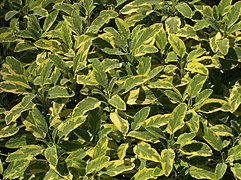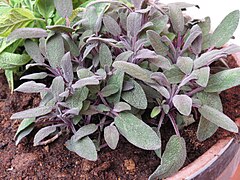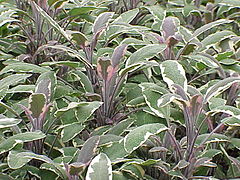Salvia officinalis
| Salvia officinalis | |
|---|---|
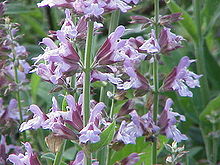
| |
| Scientific classification | |
| Kingdom: | Plantae |
| Clade: | Tracheophytes |
| Clade: | Angiosperms |
| Clade: | Eudicots |
| Clade: | Asterids |
| Order: | Lamiales |
| Family: | Lamiaceae |
| Genus: | Salvia |
| Species: | S. officinalis
|
| Binomial name | |
| Salvia officinalis | |

Salvia officinalis, the common sage or sage, is a perennial, evergreen
Names
Salvia officinalis has numerous common names. Some of the best-known are sage, common sage, garden sage, golden sage, kitchen sage, true sage, culinary sage, Dalmatian sage, and broadleaf sage. Cultivated forms include purple sage and red sage. The specific epithet officinalis refers to plants with a well-established medicinal or culinary value.[2]
Taxonomy
Salvia officinalis was described by Carl Linnaeus in 1753. It has been grown for centuries in the Old World for its food and healing properties, and was often described in old herbals for the many miraculous properties attributed to it.[3] The binary name, officinalis, refers to the plant's medicinal use—the officina was the traditional storeroom of a monastery where herbs and medicines were stored.[2][4] S. officinalis has been classified under many other scientific names over the years, including six different names since 1940 alone.[5] It is the type species for the genus Salvia.
Description

Cultivars are quite variable in size, leaf and flower color, and foliage pattern, with many variegated leaf types. The Old World type grows to approximately 60 cm (2 ft) tall and wide, with lavender flowers most common, though they can also be white, pink, or purple. The plant flowers in late spring or summer. The leaves are oblong, ranging in size up to 65 mm (2+1⁄2 in) long by 25 mm (1 in) wide. Leaves are grey-green, rugose on the upper side, and nearly white underneath due to the many short soft hairs. Modern cultivars include leaves with purple, rose, cream, and yellow in many variegated combinations.[3] The common sage gives its name to the grayish-green color sage, due to the distinctive color of its leaves.
History
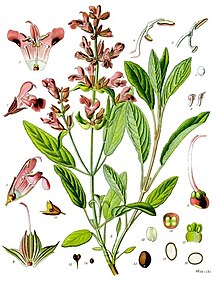
Salvia officinalis has been used since ancient times for
The plant had a high reputation throughout the Middle Ages, with many sayings referring to its healing properties and value.
Uses
Culinary use



In Britain, sage has for generations been listed as one of the essential herbs, along with
Essential oil
Common sage is grown in parts of Europe for distillation of an essential oil, although other species such as Salvia fruticosa may also be harvested and distilled with it.[citation needed]
Research
Cultivars
In favourable conditions in the garden, S. officinalis can grow to a substantial size (1 square metre or more), but a number of
Named cultivars include:
- 'Alba', a white-flowered cultivar
- 'Aurea', golden sage
- 'Berggarten', a cultivar with large leaves, which rarely blooms, extending the useful life of the leaves
- 'Extrakta', has leaves with higher oil concentrations
- 'Icterina', a cultivar with yellow-green variegated leaves
- 'Lavandulaefolia', a small leaved cultivar
- 'Purpurascens' ('Purpurea'), a purple-leafed cultivar
- 'Tricolor', a cultivar with white, purple and green variegated leaves
'Icterina'[16] and 'Purpurascens'[17] have gained the Royal Horticultural Society's Award of Garden Merit.[18]
-
'Berggarten'
-
'Icterina'
-
'Purpurascens'
-
'Tricolor'
See also
References
- . Retrieved 23 January 2024.
- ^ ISBN 9781845337315.
- ^ ISBN 978-0-88192-560-9.
- ISBN 978-0-88192-627-9.
- ISBN 978-0-88192-671-2.
- ISBN 9780738706740.
- ^ Watters, L. L. (1901). An Analytical Investigation of Garden Sage (Salvia officinalis, Linne). New York: Columbia University.
- ^ ISBN 978-90-5823-005-8.
- ^ An Anglo-Saxon manuscript read "Why should man die when he has sage?" Kintzios, p. 10
- ^ "Le Menagier de Paris". Hinson, Janet, translator. 1393.
{{cite web}}: CS1 maint: others (link) - ^ Grieve, Maud (1971). A Modern Herbal: The Medicinal, Culinary, Cosmetic and Economic Properties, Cultivation and Folk-lore of Herbs, Grasses, Fungi, Shrubs, & Trees with All Their Modern Scientific Uses, Volume 2.
- ^ Markham, Gervase (1615). The English House-wife.
- ISBN 978-0-9623719-0-5. Archived from the originalon 2021-03-02. Retrieved 2018-03-12.
- PMID 24836739.
- ^ PMID 27888449.
- ^ "RHS Plant Selector - Salvia officinalis 'Icterina'". Retrieved 5 March 2021.
- ^ "RHS Plant Selector - Salvia officinalis 'Purpurascens'". Retrieved 5 March 2021.
- ^ "AGM Plants - Ornamental" (PDF). Royal Horticultural Society. July 2017. p. 94. Retrieved 12 October 2018.



